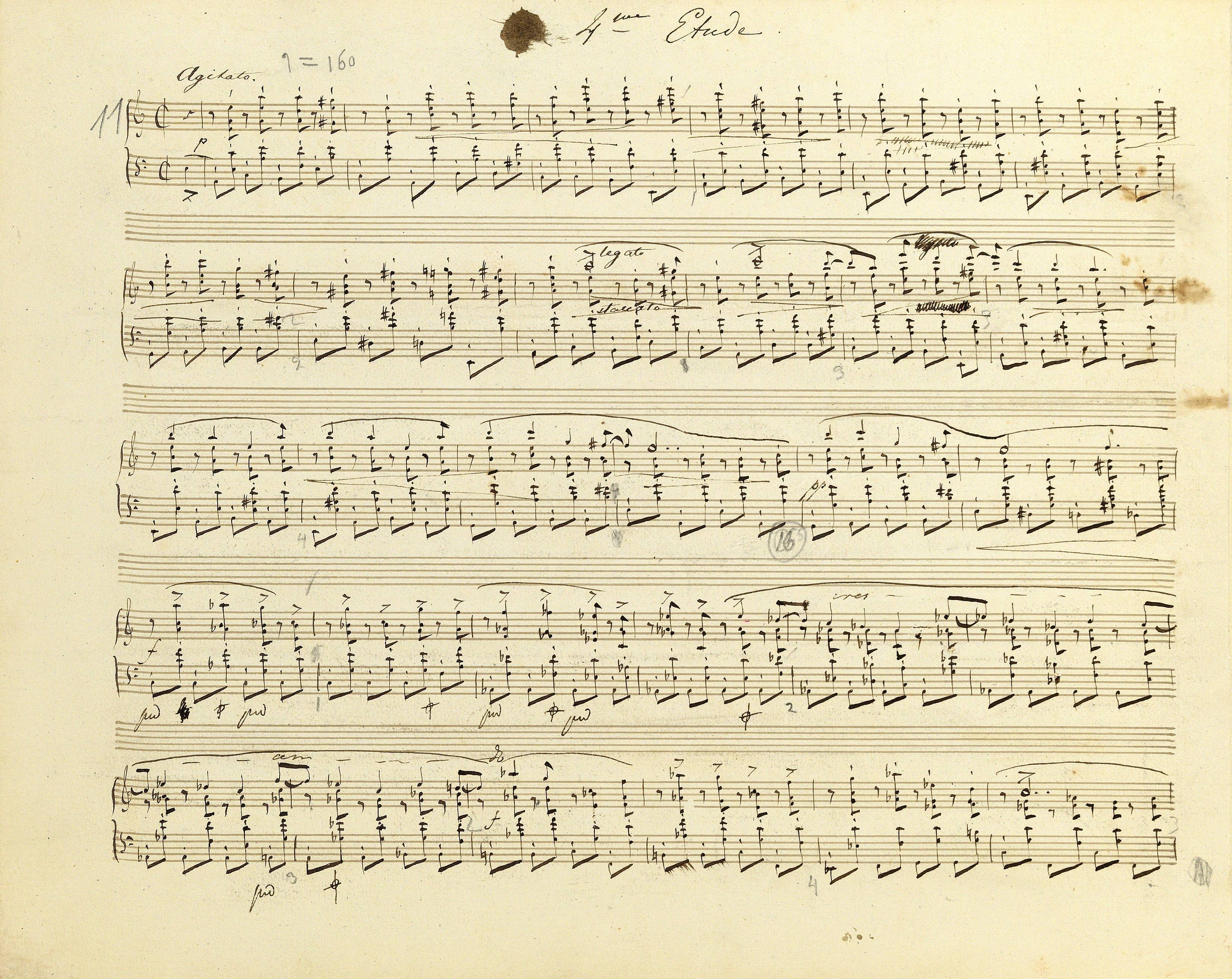



The notation of the articulation in the R.H. underwent an evolution, whose clear signs are visible in both preserved manuscripts. Initially, Chopin provided the upper voice with slurs and the dyads in the bottom one with wedges over the notes, i.e. between the voices. In relation to lack of space, some of the wedges were reduced to dots, which, in turn, could have been easily mistaken for notes in certain situations. We see such a situation in A, in which Chopin marked in this way bars 9-15 and the first chord in bar 16. However, the composer was not happy with this notation, which is proved by deletions of the majority of the previously written staccato signs (beginning from bar 11, in which the signs placed on the ledger lines turned out to be illegible); one can assume that instead of them he added legato and stacc. indications in bar 11. Eventually, he reached a conclusion that as he started determining the articulation with words, there was no reason not to do it from the beginning, which explains the addition of both indications also in bar 9. However, it is not entirely clear whether in the new situation Chopin's intention was to completely resign from staccato signs or whether he wanted to preserve them in certain circumstances. The problem concerns bars 9-10, the first chord in bar 11, the last quaver in bar 12 and the second half of bar 15 and first third in bar 16. FE generally repeats the text of A, yet three groups of differences draw attention:
- overlooking both legato indications (bars 9 and 11);
- overlooking the left in A staccato signs under the notes of the upper voice in bars 9-10 and 16;
- adding a wedge under the chord at the beginning of bar 11, absent in A (preserving the wedge written in A over this chord).
Unfortunately, the above changes do not provide a base for a reliable statement whether it is Chopin's correction or a combination of mistakes and inaccuracies of the engraver. According to us, the highest probability of authenticity occurs in the case of the first of them, the least – in the case of the second.
As far as FC is concerned, it contains a clear trace of Chopin's intervention in the form of deletion of the second pair of verbal indications (in bar 11). Completion of the wedges in bar 16 is less obvious, while the remaining differences with A seem to be accidental (overlooking the last staccato sign in bar 9, two in the 2nd half of bar 10, first in bar 11 and three in bars 15-16).
EE confirms deletion of the pair of verbal indications in bar 11. The remaining changes with respect to A may be ascribed to the copyist's or engraver's inaccuracies, yet Chopin corrections cannot be excluded.
In the main text we adopt the following solutions:
- we leave only one pair of legato and staccato indications in bar 9 (Chopin deletion in FC, confirmed by EE);
- we assume that, adding these indications, Chopin resigned from the staccato signs for the bottom voice, except for a few special situations discussed below. Therefore, we do not include the signs present in bars 9-10 and 15 and at the beginning of bar 16;
- the aforementioned exceptions are the last third in bar 12 and three last thirds in bar 16 (the wedges perhaps added by Chopin in FC); these are notes struck against the sustained note of the upper voice, embraced with the end of the slur; both situations occur at a certain distance from the verbal indications;
- we suggest a variant solution at the beginning of bar 11 – the wedge is absent in the basic source (FC), yet it is in A (→FE) and EE; its inclusion is supported by rhythmic and articulation analogy from bars 9-10, in which the beginning of the slur at the 4th quaver in the bar is preceded with a wedge on the second.
Compare the passage in the sources »
category imprint: Differences between sources; Corrections & alterations
issues: Authentic corrections of FC
notation: Verbal indications




